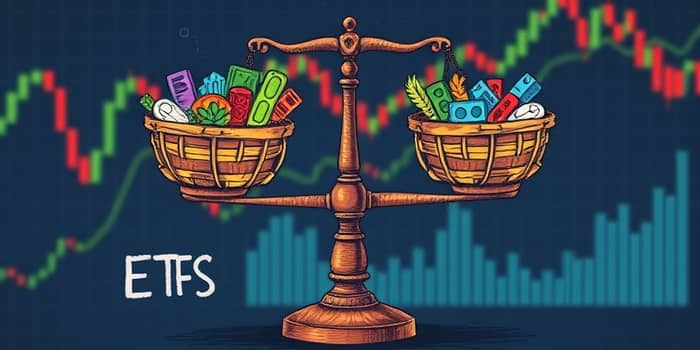Choosing the right investment vehicle can define your long-term financial success. Whether you’re just starting your journey or refining an existing portfolio, understanding how Exchange-Traded Funds (ETFs) stack up against Mutual Funds is crucial.
In this comprehensive guide, we’ll explore definitions, similarities, differences, cost considerations, and practical decision factors so you can invest with confidence.
Understanding Mutual Funds and ETFs
Mutual funds pool capital from many investors to assemble a diversified portfolio of stocks, bonds, or other securities. Managers buy and sell assets on behalf of shareholders. Transactions occur at the fund’s daily net asset value (NAV) after markets close.
ETFs offer a similar diversification benefit but trade like individual stocks on exchanges throughout the day. Prices fluctuate based on market supply and demand, giving investors real-time control over entry and exit points.
Shared Strengths: Diversification and Professional Management
Both ETFs and mutual funds help reduce risk by spreading investments across a variety of assets. Investors gain exposure to entire sectors or global markets without the need to select individual securities.
- Built-in diversification across multiple asset classes that smooths out volatility.
- Professional portfolio managers who research, select, and monitor underlying holdings.
- Access to niche and broad-market opportunities including domestic stocks, international bonds, and thematic sectors.
Key Differences to Influence Your Decision
While the core benefits overlap, the distinctions between ETFs and mutual funds can significantly impact your strategy and tax outcomes.
Cost Considerations: Fees and Tax Implications
One of the most compelling reasons to favor ETFs is their cost structure. Passive ETFs often boast median expense ratios below 0.20%, while many actively managed mutual funds exceed 0.70%. Savings can compound significantly over decades.
Additionally, ETFs’ unique creation and redemption mechanism allows them to avoid triggering taxable events for remaining shareholders. In contrast, mutual fund shareholders can receive unwanted capital gains distributions simply because other investors redeemed shares.
Flexibility and Practical Use Cases
Your personal investing style should guide your choice. ETFs shine for traders and tax-sensitive investors who value price control and minimization of capital gains. Mutual funds cater to hands-off savers who appreciate streamlined reinvestment plans.
- Intraday trading capability empowers tactical adjustments and limit orders in ETFs.
- Automatic reinvestment options allow mutual fund investors to compound returns seamlessly.
- Dollar-cost averaging strategies work naturally with scheduled mutual fund purchases.
Charting Your Path: Active vs Passive Management
ETFs predominantly track indexes, making them ideal for investors seeking market returns with minimal fees. Mutual funds split between active and passive approaches, enabling those who believe in managerial outperformance to invest in well-researched portfolios.
Consider your belief in the value of a manager’s insight. Are you comfortable accepting index returns, or are you willing to pay more in pursuit of potential alpha?
Real-World Examples and Performance Metrics
To illustrate, Vanguard’s S&P 500 ETF (VOO) charges a mere 0.03% expense ratio, while its mutual fund counterpart (VFIAX) sits at 0.04%. Despite the tiny gap, over decades these savings can grow into substantial sums.
Industry data shows U.S. ETF assets rose by 3.8% in 2025, outpacing mutual fund growth. This trend reflects a widening preference for cost-effective, transparent instruments among both retail and institutional investors.
Making the Choice: Factors to Consider
When deciding between ETFs and mutual funds, weigh these critical factors:
Trading Preference: Do you need to execute intraday trades, or do you prefer end-of-day simplicity?
Tax Sensitivity: Are you investing in a taxable account where capital gains matter?
Cost Constraint: Will lower expense ratios significantly impact your long-term returns?
Management Style: Do you believe in active management or prefer passive index tracking?
Account Type: Are you building a retirement portfolio with automatic contributions or managing a brokerage account?
Desire for Transparency: How important is it to see daily fund holdings?
Embracing the Next Steps with Confidence
Your financial future is shaped by the choices you make today. By understanding the nuances of ETFs and mutual funds, you’re equipped to craft a portfolio that aligns with your values, time horizon, and risk tolerance.
Start by evaluating a small allocation in each vehicle type to experience their differences firsthand. Monitor performance, tax impacts, and your own comfort with the trading process. Over time, you’ll develop a strategy that blends the strengths of both ETFs and mutual funds, securing a resilient and cost-effective path toward your financial goals.
References
- https://www.troweprice.com/personal-investing/resources/insights/mutual-funds-vs-etfs-which-best-for-your-investment-strategy.html
- https://www.schwab.com/etfs/mutual-funds-vs-etfs
- https://investor.vanguard.com/investor-resources-education/etfs/etf-vs-mutual-fund
- https://www.schwab.com/learn/story/etf-vs-mutual-fund-it-depends-on-your-strategy
- https://smartasset.com/investing/etf-vs-stock-vs-mutual-fund
- https://www.ici.org/faqs/faqs_etfs_other_invest
- https://www.ici.org/research/stats/combined_active_index
- https://www.youtube.com/watch?v=Gozjc0lRhQc










